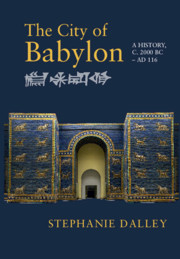Book contents
- The City of Babylon
- The City of Babylon
- Copyright page
- Contents
- Illustrations and Maps
- Preface
- Conventions
- Timeline
- Written Languages and Their Scripts
- 1 Land and Peoples
- 2 Discoveries and Excavations
- 3 First Kings to the End of the Great Rebellion, c. 1894–c. 1732
- 4 Law, Education, Literature, and the Path to Supremacy
- 5 From the Great Rebellion to the End of the First Dynasty, c. 1732–1592
- 6 The Next Six Centuries
- 7 In the Shadow of Assyria, 978–625
- 8 Empire
- 9 From the Death of Nebuchadnezzar II to the Death of Cambyses, 561–522
- 10 Darius I to Alexander, and Seleucid to Parthian Rule
- 11 First Parthian Conquest, 141 BC, to the Visit of Trajan in AD 116
- Appendix: Genesis 14:1–16 and Possible Links with Foreign Rulers Early in the Reign of Hammurabi
- Bibliography
- Index
4 - Law, Education, Literature, and the Path to Supremacy
Published online by Cambridge University Press: 23 June 2021
- The City of Babylon
- The City of Babylon
- Copyright page
- Contents
- Illustrations and Maps
- Preface
- Conventions
- Timeline
- Written Languages and Their Scripts
- 1 Land and Peoples
- 2 Discoveries and Excavations
- 3 First Kings to the End of the Great Rebellion, c. 1894–c. 1732
- 4 Law, Education, Literature, and the Path to Supremacy
- 5 From the Great Rebellion to the End of the First Dynasty, c. 1732–1592
- 6 The Next Six Centuries
- 7 In the Shadow of Assyria, 978–625
- 8 Empire
- 9 From the Death of Nebuchadnezzar II to the Death of Cambyses, 561–522
- 10 Darius I to Alexander, and Seleucid to Parthian Rule
- 11 First Parthian Conquest, 141 BC, to the Visit of Trajan in AD 116
- Appendix: Genesis 14:1–16 and Possible Links with Foreign Rulers Early in the Reign of Hammurabi
- Bibliography
- Index
Summary
The content and significance of Hammurabi’s law code stela, including material and artistic aspects as well as text, are described and related to earlier law codes from other cities and biblical parallels. Protection of property, trade, family, warfare, and personal injury are among the topics. The separate content of its prologue and epilogue are discussed. The system of scribal education that lay behind its composition, from primary school to tertiary, was based on a formal curriculum beginning with sign lists and word lists. Model contracts and model letters, and extracts from myths and epics are found alongside satire and humour. The importance of divination and oracles for military success is emphasized. Precursors to themes later found in the Epic of Creation, such as gods waging war against Chaos can already be found in contemporary literature. The rise of Marduk can be traced in relation to Hammurabi’s conquests. The downside of warfare is explored in the Poem of Agushaya. The Epic of Creation is of central importance for Marduk and Babylon as world leaders, superseding earlier claimants. Epics from southern Mesopotamia are earlier and do not feature Marduk or Babylon.
Keywords
- Type
- Chapter
- Information
- The City of BabylonA History, c. 2000 BC – AD 116, pp. 77 - 105Publisher: Cambridge University PressPrint publication year: 2021

